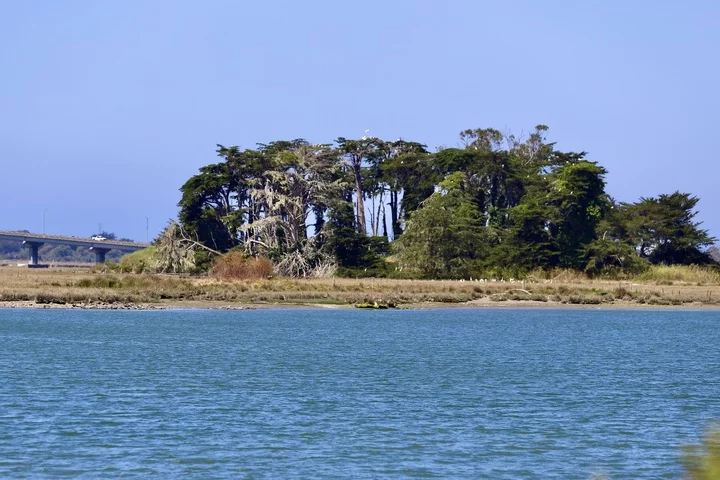Tuluwat Island. | Photo by Andrew Goff.
###
Cody Hills didn’t know exactly what he’d seen.
It was late, sometime around 2 a.m., when the motion-activated LED lights outside his house clicked on. He ventured outside to investigate and heard the sounds of an animal on his deck. That’s when he saw it: the hind end of … something going over the edge of the deck and disappearing into the night.
Could that have been a bear? he wondered.
“The next morning I thought I was going crazy,” he said. “I’d never seen a bear out here. … I’m used to deer and raccoons.”
Hills is among the handful of people who live full-time on Tuluwat Island, the 280-acre land mass (formerly known as Indian Island) located in the middle of Humboldt Bay. Historically home to two indigenous Wiyot villages and site of the 1860 Wiyot massacre, the stolen island was largely returned to tribal ownership in 2019.
Could a bear really make it out there? Hills doubted himself, even after he saw that his bird feeder had been knocked over. But then he started talking to his neighbors. One told him about his plum tree, which had been torn apart two nights earlier. (The neighbor initially suspected raccoons.)
Former Eureka Mayor Nancy Flemming, who has lived on the island for four decades, said she, too, found evidence of the animal.
“Yes,” she said when reached by phone this afternoon. “Definitely there was a bear.”
Flemming raises chickens, storing their feed inside a metal trashcan with the lid held down by bungie cord.
”And [the bear] took the lid off the garbage can and turned it over,” Flemming said.
How the heck did it get out there?
”I have no idea,” Flemming said, “although some people have said they can swim, and the deer go back and forth constantly. We see them.” But in the 40 years she’s lived on the island she’s never once heard of a bear out there, much less seen one.
Hills’ dad is Leroy Zerlang, chair of the Humboldt Bay Harbor Safety Committee and operator of the 113-year-old M.V. Madaket, the nation’s oldest passenger ferry, which now offers guided tours of Humboldt Bay.
Reached by phone, Zerlang said nobody on the Madaket has spotted a bear, but he has no doubt that it was there. He took a call from the neighbor with the damaged plum tree, who said all the branches had been ripped off and his raccoon trap had been “totally destroyed and thrown across the yard.”
“My dad tells stories of seeing bears swimming across the bay all the time,” said the 65-year-old Zerlang, who added that deer make that swim regularly.
Zerlang had fun talking to his son about the bear. “I go, ‘How big was the son of a bitch?’ and he said, ‘Bigger than your goat.’ And my goat’s fat!” Zerlang said.
The day after his partial sighting, which occurred week before last, Hills went searching around the perimeter of his property, investigating for clues, and before long he found a single footprint in the mud, roughly as wide as a man’s hand and in the unmistakeable shape of a black bear’s paw.
Photo courtesy Cody Hills.
###
Austin Reeder, human-wildlife conflict specialist for the California Department of Fish & Wildlife, said he took a report about the bear sighting last week.
“We do have quite a few bears in Humboldt County, and they can get all sorts of places,” Reeder said. “It doesn’t surprise me that one would swim out to Tuluwat Island. Anyplace there’s a food source a bear will tune into that and head towards it.”
He said CDFW personnel try to work with residents to make sure their trash and other potential ursine-tempting items are secured so bears will return to their natural habitat.
Hills hasn’t seen any signs of the bear since he spotted that footprint, nor has Flemming.
“Hopefully it left,” she said.


CLICK TO MANAGE